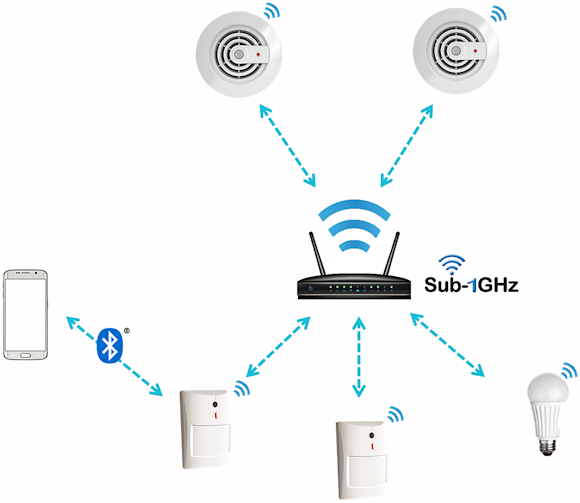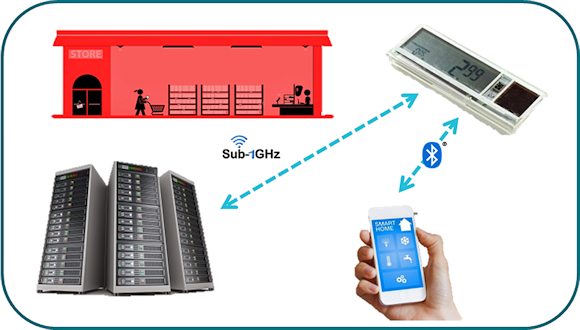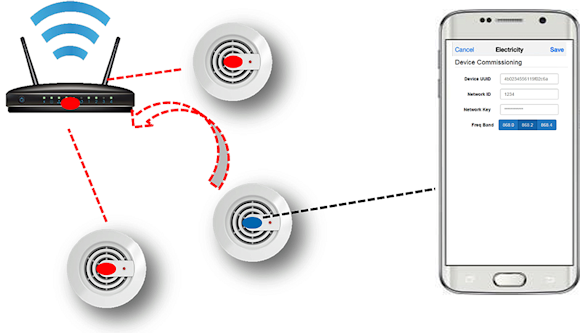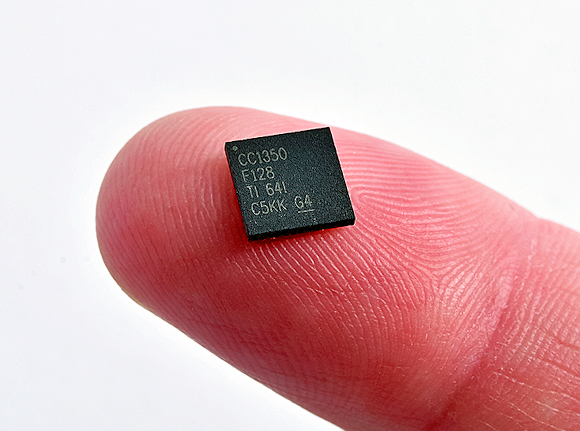
In the recent months, we have seen wireless system-on-chip (SoC) devices introduced to the market that are equipped with dual-band operation capabilities supporting both Sub-1 GHz and Bluetooth low energy technologies. This ability opens up a new horizon of opportunities for building smarter wireless sensor networks. Traditionally, sensors have communicated with a centralized panel or from sensor to sensor directly. With the addition of Bluetooth low energy, the sensors can not only communicate as before, but also communicate directly with a smartphone or a tablet.
Wireless sensors are well known and heavily deployed in households and buildings. In recent years, technology improvements such as improved RF performance, lower-power consumption, easier integration and lower cost have made wireless communication the preferred way of connecting sensors. Wireless sensor networks offer a simple, cost efficient installation process and are easier to scale over wired networks.
Sub-1 GHz is a common RF technology used for wireless sensor communication. Thanks to its physical characteristics, Sub-1 GHz technology achieves a longer range and better penetration through walls compared to other technologies that are based on the 2.4 GHz band. Sub-1 GHz is often the technology of choice for sensor networks. Using a standard protocol like the IEEE 802.15.4g over the Sub-1 GHz band would allow a developer to build a robust and secure multi-sensor network that communicates to a central unit without the need to invent a proprietary protocol.

Fig. 1: A Sub-1 GHz star network using dual-band connectivity to connect to a smartphone.
Now by using a dual-band wireless device such as the SimpleLink dual-band CC1350 wireless microcontroller (MCU), it is easy to add Bluetooth low energy to the Sub-1 GHz end-node sensors. This capability opens the way to endless new use cases and applications that communicate directly with the wireless sensor. The wireless sensor end node is then part of the Sub-1 GHz network which is connected to a gateway or panel, but it can now also communicate with a smartphone directly.
Next page
Sensor Installation
A common use case for using dual-band connectivity is the ease of installation. Once a sensor is mounted and before it is connected to the Sub-1 GHz network, the technician connects his phone to the sensor over Bluetooth low energy for initial setup. Sensor products are designed to be small, low cost and low power and hence they don't have a user interface. Common existing setup options require jumper settings on the PCB, dipswitch settings or other buttons.
Obviously, the level of configuration using those methods is very limited. Once a Bluetooth low energy connection has been established with the sensor, the phone becomes the user interface and advanced configuration is made natural via a phone app. It allows the technician to easily configure the sensor connection to the Sub-1GHz network.
Network security credentials can be configured along with other network properties like regulatory constraints for frequency of operation and output power, frequency hopping, device ID, period of updates and so on. This ability helps the manufacture to build generic solutions that are configured in the field rather than in the factory.
System Updates
Software updates to the sensor is another function that can be easily applied using the Bluetooth low energy connection with a smartphone. Software updates has become very common process for every connected electronic device from smartphones to smart TVs to coffee machines.
Connected sensors can enjoy this capability as well. With a Bluetooth low energy connection, the technician or owner can easily get updated software from the cloud and push it to the sensor. Bug fixes, product enhancements or changes dictated by new regulations can all be addressed with new software.
The software update capability allows manufactures to shorten their time to market and stretch the lifetime of hardware platforms. Benefits to end customers include easier troubleshooting and up-to-date products.
Bluetooth Low-Energy Advertising By Sensors
So far, we have discussed how a Bluetooth low energy connection can improve the installation experience and add benefits to both the customer and the manufacturer. Bluetooth low energy advertisement technology, which is part of the Bluetooth LE standard, provides more options and enables more interesting use cases for sensors. Bluetooth low energy advertisement does not require connection with the phone or any action taken by the target phone except for having the Bluetooth turned on.
With Bluetooth, low energy advertisement, (Bluetooth beacons) the sensor can literally speak. Sensors can send information directly to smartphones based on proximity. The information can consist on data gathered by the sensor itself or it can be pushed from a central control.

Fig. 2: Configure Bluetooth low energy advertisements via a long-range Sub-1 GHz server.
Next page
Smoke Alarm Network And Environmental Sensors
Interconnected smoke alarms are both recommended and required in buildings or homes by code in most states. With interconnected smoke alarms, when one alarm sounds they all sound. It provides early warning and ensures you hear the alarm anywhere in the home or building.
Wireless interconected smoke alarms using Sub-1 GHz technology are available in the market eliminating the installation re-wiring hassle. The smoke alarms may be part of a larger safety network containing other sensors and connected to a centrelized panel or they may form a network themselves.
In both cases, having the main network based on Sub-1GHz technology is a good way to ensure full house or building coverage. Adding Bluetooth low energy technology to these alarms will add more options and functionality. Consider a hotel with smoke alarms in every room, once an alarm goes off, each smoke sensor can send a Bluetooth low energy advertisment message to the room with information regarding the emergency escape route. It also benefits people who are hearing impaired, as they cannot hear the alarm but can feel the vibration of their phone.
Small smoke alarm networks that are not connected to a centrelized panel can benefit from the addition of Bluetooth low energy simply by allowing the user to check the status of the network or the battery via their phone. Monitoring a closed smoke alarm network has never been easier.
Smoke detection sensors as well as other gas sensors like carbon monoxide, carbon dioxide, combustible gas, radon gas and others usualy provide a single binary indication based on a threshold. With Bluetooth low energy, you can add a simple enhancement to any of these sensors that can now send the detailed statuses of their measurements. Users can better learn about the environment condition before the emergency occurs. Extended presence of small amouts of gas might not trigger the alarm, but it might be crucial information for the end user.

Fig. 3: Commissioning devices to a Sub-1 GHz network via Bluetooth low energy.
Next page
Automatic Door
Consider an automatic door in a public facility, like the library or a government office, which will use the door sensor to send messages to visitors entering the building. When the facility is closed, it can send the opening hours and when open it can publish some orientation information. The message is pushed from central control unit to all door motion sensors over the Sub-1Ghz network that these sensors are connected to anyway. The sensors then forward the message using the Bluetooth low energy advertisement upon trigger of the sensor.

Fig. 4: Automatic door sensors connected by Sub-1 GHz deliver information via Bluetooth low energy to the smartphone.
Parking Lot
Think about a public parking lot that has an occupancy sensor for each spot. The sensor monitors whether a spot is vacant or occupied and communicates to a central control that guides drivers to the vacant spots using electronic signs. Once a car is parked in a spot, the sensor then sends a Bluetooth low energy advertisement message with the details of the spot, helping the driver remember where the car is parked. In this example again, Sub-1 GHz is used to form the main network that communicates long distances reliably and the Bluetooth low energy addition enhances the end user experience.

Fig. 5: Access to an occupancy sensor network in a parking garage on a smartphone.
Next page
Building Location
Bluetooth low energy beacons are widely used in buildings for in-door location systems. This technology is gaining more and more popularity and many commercial buildings are adding them to their networks. With dual-mode devices, any existing fire detector for example can also be part of the beacon location network. Since many sensors are installed in buildings by law, having them cover both functions can save equipment, installation and maintenance costs.
End-to-End Sensor System With Ultra-Low Power SimpleLink Wireless MCU
TI's SimpleLink dual-band CC1350 wireless MCU is a new wireless system-on-chip solution that offers both the long-range RF connectivity of the Sub-1 GHz frequency band and the simple connectivity of Bluetooth low energy (2.4 GHz) in the same device. The small size of the CC1350 solution and its low power consumption make it great for building the systems described earlier.
Its MCU is powered by an ARM Cortex-M3 at 48-MHz clock speed with 128-KB flash and 20-KB ultra-low leakage RAM. It is equipped with all necessary peripherals such as an a/d converter (ADC), I2C, UART, GPIOs, and more to build your sensor around it.
The CC1350 device also contains a unique sensor controller unit that can work while the rest of the system is off. The sensor controller is powered by very-low power processing unit and allows you to monitor the sensors continuously in record low current consumption. Wake the main core only when it is needed. This feature enables 10+ years of lifetime running on a coin cell battery.

Fig. 6: Tiny SimpleLink CC1350 wireless MCU with dual-band connectivity.
The Sub-1 GHz portion of the CC1350 solution comes with a complete IEEE 802.15.4 stack that allows building a standard star network. It handles all the communication aspects such as medium access, security, addressing, retries and acknowledgements.
TI displays the complete solution with its Sub-1 GHz Sensor to Cloud reference design showing connection from end-node sensors to the cloud using 802.15.4 protocol and an Ethernet gateway. Apart from 802.15.4 stack, the CC1350 solution comes with proprietary stack called EasyLink that allows developers to build their own communication protocol using a very simple set of APIs and without having to hassle with complex radio and RF configurations.
On top of the two stacks mentioned above, TI also provide a Bluetooth 4.2 compliant BLE-Stack that allows Bluetooth low energy connection or Bluetooth low energy advertising for the CC1350 device.
About the Author
Ben Gilboa is a marketing system engineer for low power connectivity, wireless connectivity solutions at Texas Instruments (TI). During his 10 years in wireless connectivity at TI, Gilboa has held numerous roles including applications group manager for the SimpleLink Wi-Fi products, WLAN systems team leader and VLSI engineer. Gilboa has a master's of business administration and finance from Tel Aviv University where he also received a bachelor's in electrical engineer.
Related Stories
Wireless Sensor Use Is Expanding in Industrial Applications
Mobile Phone Tracking Boosts Amusement Park Experience And Revenue